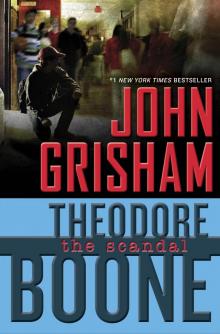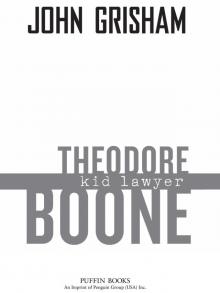- Home
- John Grisham
The Chamber Page 3
The Chamber Read online
Page 3
Chapter 3
RUTH and Marvin Kramer separated in 1970. He was admitted to a mental hospital later that year, and committed suicide in 1971. Ruth returned to Memphis and lived with her parents. In spite of their problems, they had pressed hard for a third trial. In fact, the Jewish community in Greenville was highly agitated and vocal when it became apparent that the district attorney was tired of losing and had lost his enthusiasm for prosecuting Cayhall and Dogan.
Marvin was buried next to his sons. A new park was dedicated to the memory of josh and John Kramer, and scholarships were established. With time, the tragedy of their deaths lost some of its horror. Years passed, and Greenville talked less and less about the bombing.
Despite pressure from the FBI, a third trial did not materialize. There was no new evidence. The judge would no doubt change venue again. A prosecution looked hopeless, but still the FBI did not quit.
With Cayhall unwilling and Wedge unavailable, Dogan's bombing campaign fizzled. He continued to wear his robe and make his speeches, and began to fancy himself as a major political force. Journalists up North were intrigued by his blatant race-baiting, and he was always willing to put on his hood and give outrageous interviews.
He was mildly famous for a brief period, and he enjoyed it immensely.
But by the late 1970s, Jeremiah Dogan was just another thug with a robe in a rapidly declining organization. Blacks were voting. The public schools were desegregated. Racial barriers were being struck down by federal judges throughout the South. Civil rights had arrived in Mississippi, and the Klan had proven pitifully inept in keeping Negroes where they belonged. Dogan couldn't draw flies to a cross-burning.
In 1979, two significant events occurred in the open but inactive Kramer bombing case. The first was the election of David McAllister as the district attorney in Greenville. At twenty-seven he became the youngest D. A. in the state's history. As a teenager he had stood in the crowd and watched the FBI pick through the rubble of Marvin Kramer's office. Shortly after his election, he vowed to bring the terrorists to justice.
The second event was the indictment of Jeremiah Dogan for income tax evasion. After years of successfully dodging the FBI, Dogan got sloppy and ran afoul of the IRS. The investigation took eight months and resulted in an indictment that ran for thirty pages. According to it, Dogan had failed to report over a hundred thousand dollars between 1974 and 1978. It contained eighty-six counts, and carried a maximum of twenty-eight years in prison.
Dogan was dead guilty, and his lawyer (not Clovis Brazelton) immediately began exploring the possibility of a plea bargain. Enter the FBI.
Through a series of heated and angry meetings with Dogan and his lawyer, a deal was offered by the government whereby Dogan would testify against Sam Cayhall in the Kramer case, and in return he would serve no time in jail for tax evasion. Zero days behind bars. Heavy probation and fines, but no jail. Dogan had not spoken to Cayhall in over ten years. Dogan was not active in the Klan anymore. There were lots of reasons to consider the deal, not the least of which was the issue of remaining a free man or spending a decade or so in prison.
To prod him along, the IRS attached all of his assets, and planned a nice little fire sale. And to help with his decision, David McAllister convinced a grand jury in Greenville to indict him and his pal Cayhall once again for the Kramer bombing.
Dogan caved in and jumped at the deal.
* * *
After twelve years of living quietly in Ford County, Sam Cayhall once again found himself indicted, arrested, and facing the certainty of a trial and the possibility of the gas chamber. He was forced to mortgage his house and small farm to hire a lawyer. Clovis Brazelton had gone on to bigger things, and Dogan was no longer an ally.
Much had changed in Mississippi since the first two trials. Blacks had registered to vote in record numbers, and these new voters had elected black officials. All-white juries were rare. The state had two black trial judges, two black sheriffs, and black lawyers could be spotted with their white brethren roaming the courthouse hallways. Officially, segregation was over. And many white Mississippians were beginning to look back and wonder what all the fuss was about. Why had there been such resistance to basic rights for all people? Though it had a long way to go, Mississippi was a far different place in 1980 than in 1967. And Sam Cayhall understood this.
He hired a skilled trial advocate from Memphis named Benjamin Keyes. Their first tactic was to move to dismiss the indictment on the grounds that it was unfair to try him again after such a delay. This proved to be a persuasive argument, and it took a decision by the Mississippi Supreme Court to settle the matter. By a vote of six to three, the court ruled that the prosecution could proceed.
And proceed it did. The third and final trial of Sam Cayhall began in February of 1981, in a chilly little courthouse in Lakehead County, a hill county in the northeastern corner of the state. Much could be said about the trial. There was a young district attorney, David McAllister, who performed brilliantly but had the obnoxious habit of spending all his spare time with the press. He was handsome and articulate and compassionate, and it became very clear that this trial had a purpose. Mr. McAllister had political ambitions on a grand scale.
There was a jury of eight whites and four blacks. There were the glass sample, the fuse, the FBI reports, and all the other photos and exhibits from the first two trials.
And then, there was the testimony of Jeremiah Dogan, who took the stand in a denim workshirt and with a humble countenance solemnly explained to the jury how he conspired with Sam Cayhall sitting over there to bomb the office of Mr. Kramer. Sam glared at him intensely and absorbed every word, but Dogan looked away. Sam's lawyer berated Dogan for half a day, and forced him to admit that he'd cut a deal with the government. But the damage was done.
It was of no benefit to the defense of Sam Cayhall to raise the issue of Rollie Wedge. Because to do so would be to admit that Sam in fact had been in Greenville with the bomb. Sam would be forced to admit that he was a coconspirator, and under the law he would be just as guilty as the man who planted the dynamite. And to present this scenario to the jury, Sam would be forced to testify, something neither he nor his attorney wanted. Sam could not withstand a rigorous cross-examination, because Sam would be forced to tell one lie to cover the last.
And, at this point, no one would believe a sudden tale of a mysterious new terrorist who'd never been mentioned before, and who came and went without being seen. Sam knew the Rollie Wedge angle was futile, and he never mentioned the man's name to his own lawyer.
* * *
At the close of the trial, David McAllister stood before the jury in a packed courtroom and presented his closing argument. He talked of being a youngster in Greenville and having Jewish friends. He didn't know they were different. He knew some of the Kramers, fine folks who worked hard and gave back to the town. He also played with little black kids, and learned they made wonderful friends. He never understood why they went to one school and he went to another. He told a gripping story of feeling the earth shake on the morning of April 21, 1967, and running in the direction of downtown where smoke was drifting upward. For three hours, he stood behind the police barricades and waited. He saw the firemen scurry about when they found Marvin Kramer. He saw them huddle in the debris when they found the boys. Tears dripped down his cheeks when the little bodies, covered in white sheets, were carried slowly to an ambulance.
It was a splendid performance, and when McAllister finished the courtroom was silent. Several of the jurors dabbed at their eyes.
* * *
On February 12, 1981, Sam Cayhall was convicted on two counts of capital murder and one count of attempted murder. Two days later, the same jury in the same courtroom returned with a sentencing verdict of death.
He was transported to the state penitentiary at Parchman to begin waiting for his appointment with the gas chamber. On February 19, 1981, he first set foot on death row.
>

 Playing for Pizza
Playing for Pizza The King of Torts
The King of Torts Theodore Boone: Kid Lawyer
Theodore Boone: Kid Lawyer Skipping Christmas
Skipping Christmas Ford County
Ford County Partners
Partners The Last Juror
The Last Juror A Painted House
A Painted House A Time to Kill
A Time to Kill The Innocent Man
The Innocent Man Sycamore Row
Sycamore Row The Runaway Jury
The Runaway Jury The Racketeer
The Racketeer Rogue Lawyer
Rogue Lawyer The Appeal
The Appeal Camino Island
Camino Island Gray Mountain
Gray Mountain The Firm
The Firm The Testament
The Testament The Scandal
The Scandal The Brethren
The Brethren Calico Joe
Calico Joe The Associate
The Associate The Pelican Brief
The Pelican Brief The Abduction
The Abduction The Activist
The Activist The Street Lawyer
The Street Lawyer The Rooster Bar
The Rooster Bar The Summons
The Summons The Fugitive
The Fugitive The Accused
The Accused The Broker
The Broker The Client
The Client The Litigators
The Litigators The Whistler
The Whistler The Rainmaker
The Rainmaker The Confession
The Confession The Partner
The Partner Witness to a Trial
Witness to a Trial Bleachers
Bleachers The Chamber
The Chamber A Time for Mercy
A Time for Mercy The Reckoning
The Reckoning![[Theodore Boone 02] - The Abduction Read online](http://i1.bookreadfree.com/i/03/23/theodore_boone_02_-_the_abduction_preview.jpg) [Theodore Boone 02] - The Abduction
[Theodore Boone 02] - The Abduction The Accused tb-3
The Accused tb-3 Theodore Boone: The Activist
Theodore Boone: The Activist Gray Mountain: A Novel
Gray Mountain: A Novel The Confession: A Novel
The Confession: A Novel The abduction tb-2
The abduction tb-2 Theodore Boone: The Scandal
Theodore Boone: The Scandal Theodore Boone: The Accused
Theodore Boone: The Accused The Activist tb-4
The Activist tb-4 Ford Country
Ford Country Kid Lawyer
Kid Lawyer Sycamore Row jb-2
Sycamore Row jb-2 Chamber
Chamber Three Classic Thrillers
Three Classic Thrillers